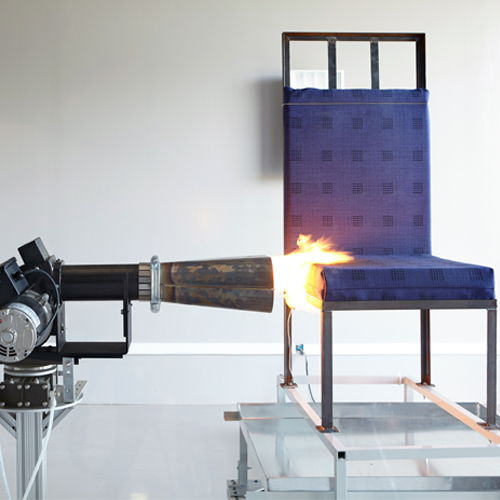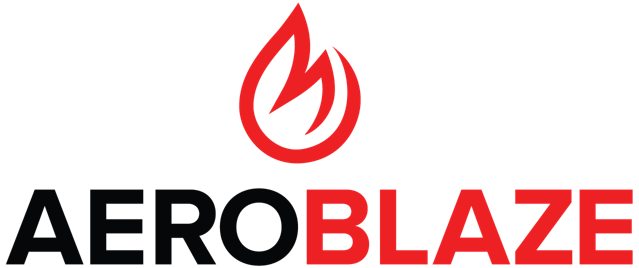Oil Burn for Seat Cushion (Fireblock)
Oil Burn for Seat Cushion (Fireblock) Test
The Oil Burn for Seat Cushion test, also known as the Fireblock test, is used to determine burn resistance and weight loss characteristics of seat cushions when exposed to a high-intensity open flame.
Test Methods

Test Summary
A sample consisting of both a bottom and back cushion is placed on the seat frame test fixture. The sample is exposed to a high intensity open flame for two minutes. After the test is completed, the weight loss is calculated and the burn lengths on the four faces of the cushions are measured. The pass/fail criteria are based on the weight loss and burn lengths averaged across three test samples.
Test Sample Requirements
For an in-depth guide to constructing the seat cushion test samples, take a look at our guide How to Build Seat Cushion Fireblock Test Samples.
Test samples must meet the following requirements:
Regulatory Requirements
This test is typically used to show compliance with the following U.S. Federal Regulations:
Note 1: In the aviation industry, 14 CFR may also be referred to as "FAR" (Federal Aviation Regulations). You may see the requirements listed as FAR 25.853, FAR 29.853, etc.
Note 2: The European Union Aviation Safety Agency (EASA) uses similar Certification Specifications (CS) which correspond to those in the CFR. For example, the EASA regulations are listed as CS 25.853, etc. These regulations may also be referred to as "JAR" (Joint Aviation Requirements) and listed as JAR 25.853, etc.
Products Requiring This Test
Certain items in transport category aircraft and in transport category rotorcraft require the Oil Burn for Seat Cushion test when they are located in a compartment occupied by the passengers. While there are some exceptions, these items typically include:
History of the Oil Burn for Seat Cushion (Fireblock) Test
Following a number of incidents during the 1970s in which fatalities occurred as a result of postcrash fires, the Federal Aviation Administration (FAA) established the Special Aviation Fire and Explosion Reduction (SAFER) Advisory Committee in 1978. The SAFER committee was directed to "examine the factors affecting the ability of the aircraft cabin occupant to survive in a post-crash environment." The committee provided findings and recommendations to many different issues, one of which was the development of a fire blocking layer for seat cushions as a means of slowing flame spread.
Seat cushions on aircraft make up a large fuel mass in the event of a fire. Although these materials were already required to pass the Vertical Bunsen Burner Test, in a full-scale cabin fire the large volume of foam allowed flames to spread quickly and produced vast amounts of smoke and combustible gases. The FAA began to research potential fire blocking concepts. One phase of this research program developed a test for evaluation and certification of cushions using a 2 gallon per hour kerosene burner. This burner was currently used for testing hose assemblies, tubing, and similar components.
Following this research, the FAA issued Notice of Proposed Rulemaking (NPRM) No. 83-14 to establish additional flammability requirements for seat cushions used in transport category aircraft. This was incorporated into federal law one year later in 1984 when the final rule was issued. This final rule established new flammability requirements for aircraft seat cushions on transport category aircraft and rotorcraft. 14 CFR 25.853 was amended to add paragraph (c) and 14 CFR 29.853 was amended to add paragraph (b). Both paragraphs required seat cushions to meet the requirements added into the newly formed 14 CFR 25, Appendix F, Part II.
The Oil Burn for Seat Cushion (Fireblock) test underwent a few changes since its creation in 1984. Individual manufacturers and organizations also established their own internal versions of the Oil Burn for Seat Cushion (Fireblock) Test, such as Airbus (ABD0031/AITM 2.0009), Boeing (BSS 7303), and McDonnell Douglas (DMS 2274).
In order to facilitate improvements to the test standard without constantly changing the CFR, the FAA published Report DOT/FAA/CT-99/15 "Aircraft Materials Fire Test Handbook" in 1990. The tests in this handbook are considered an acceptable equivalent to those in the CFR. The handbook was updated in 2000 to DOT/FAA/AR-00/12, with the Oil Burn for Seat Cushion (Fireblock) Test located in Chapter 7 of the handbook.
Sources: FAA Report DOT/FAA/FT-82/132 / FAA Report DOT/FAA/FT-83/29 / Federal Register Vol. 48, No. 197 / Federal Register Vol. 49, No. 209
Additional Resources
| Resource | Description |
|---|---|
| How to Build Seat Cushion Fireblock Test Samples |
Aeroblaze Laboratory Guide: How to Build Seat Cushion Fireblock Test Samples This document provides guidance on building seat cushion test samples for the Oil Burn for Seat Cushion (fireblock) test. |
| 14 CFR 25.853 |
Compartment Interiors (Transport Category Airplanes) U.S. Regulations for FAR 25.853 at Amendment 25-116. |
| 14 CFR 25, Appendix F |
Appendix F to Part 25 (Transport Category Airplanes) U.S. Regulations, Criteria and Test Procedures. |
| 14 CFR 29.853 |
Compartment Interiors (Transport Category Rotorcraft) U.S. Regulations for FAR 29.853 at Amendment 29-30. |
|
FAA Fire Test Handbook, Chapter 7 |
FAA Aircraft Materials Fire Test Handbook (DOT/FAA/AR-00/12); Chapter 7; Oil Burn Test for Seat Cushions. This handbook provides an acceptable means of compliance with the relevant regulations. This is the preferred test method to find compliance with the listed regulations. |
|
FAA Advisory Circular AC 25.853-1 |
Flammability Requirements for Aircraft Seat Cushions This advisory circular provides guidance material for demonstrating compliance with the Federal Aviation Regulations (FAR) pertaining to flammability of aircraft seat cushions. |
Ask the Experts

Stuck? Our experts will help you determine the best solution for your needs.
Contact Us